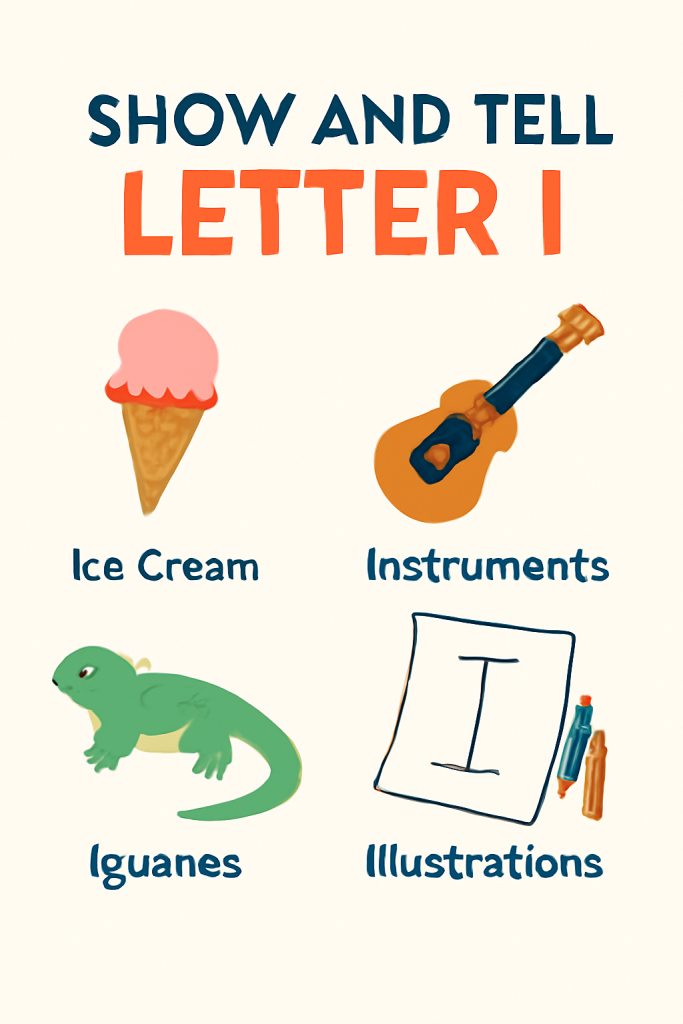Welcome to the “Show and Tell Letter I” — a fun and engaging way to introduce young learners to the wonders of the alphabet! As parents, teachers, or caregivers, we know how important it is to make early literacy learning both enjoyable and interactive. “Show and Tell” activities offer a perfect opportunity to bring the letter “I” to life, making learning a hands-on experience for children.

Why Focus on Letter I?
The letter “I” is one of the most exciting letters in the alphabet because it introduces a world of fun and interesting words. From animals like “iguanas” to everyday items like “ice cream” and “instruments,” the letter I is filled with exciting possibilities for children to explore. Using the “Show and Tell” method, we can bring these words to life, helping children engage with both the letter and the world around them.
1. Ice Cream: A Cool Way to Learn the Letter I
Let’s start with something that will definitely grab their attention: Ice cream! Everyone loves it, and it’s a great way to associate the letter “I” with something fun. You can start by showing them pictures of different ice cream flavors or, even better, bring some ice cream to class (or home) and enjoy a “Show and Tell” session.
- What to do: Ask the kids to share their favorite ice cream flavors.
- Extra Tip: If you want to get creative, have the children describe the color, shape, and taste of their favorite ice cream. This adds sensory details to the lesson, helping them connect with the letter “I” in a more immersive way.
2. Instruments: Let’s Make Music with the Letter I
Instruments are another fantastic way to introduce “I.” Children often love music, and the chance to play or listen to different instruments can help reinforce learning in a fun way.
- What to do: Introduce various musical instruments like the “instruments” of the orchestra (e.g., “instruments” like “guitar,” “trumpet,” or “piano”). If possible, let the children try playing simple instruments like tambourines or maracas.
- Extra Tip: Play a short song and ask the children to identify which instruments they can hear. This will reinforce their understanding of the letter “I” through both auditory and kinesthetic learning.
3. Iguanas: Discovering Nature and the Letter I
Next up, let’s talk about something from nature — “Iguanas.” These fascinating reptiles are not only visually interesting but also come with plenty of fun facts that will make your lesson stand out.
- What to do: Show pictures or videos of iguanas and discuss their features.
- Extra Tip: Share interesting facts, like how iguanas use their long tails for balance or how they change color. This will spark curiosity in children and deepen their connection to the letter “I.”
4. Illustrations: Draw the Letter I and Its Words
An interactive way to help children remember the letter “I” is through drawing. Encourage children to make their own illustrations using the letter “I.” They could draw “igloos,” “icebergs,” or even “insects”!
- What to do: Have the children draw objects that start with “I” and create a colorful alphabet wall.
- Extra Tip: Make the drawing activity more fun by letting them decorate their illustrations with stickers or markers.
5. I Spy Game: A Fun Way to Reinforce Letter I
Finally, let’s wrap up with a classic activity: “I Spy with my little eye…” This simple yet effective game encourages children to spot objects that start with the letter “I.”
- What to do: Take turns saying “I spy with my little eye something that starts with the letter I.” Let the children guess the object, such as an “ice cube” or “ink.”
- Extra Tip: Create a mini scavenger hunt in the classroom or at home where children search for “I” objects.
Conclusion: Make Learning the Letter I Fun and Interactive!
Teaching the letter “I” can be an exciting and memorable adventure for children. By using engaging activities like “Ice Cream,” “Instruments,” “Iguanas,” “Illustrations,” and the “I Spy” game, kids will not only recognize the letter “I” but also connect it to real-world objects and experiences. These interactive and creative “Show and Tell” activities will ensure your little learners stay engaged while mastering this important letter.
Remember, learning through play is one of the most effective ways to teach young children, and by using these strategies, you'll be fostering a love for learning that will last a lifetime.
Add Comment
Find ideas by letter
Explore crafts, songs, printables, books, and easy items to bring for each letter.